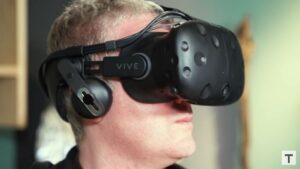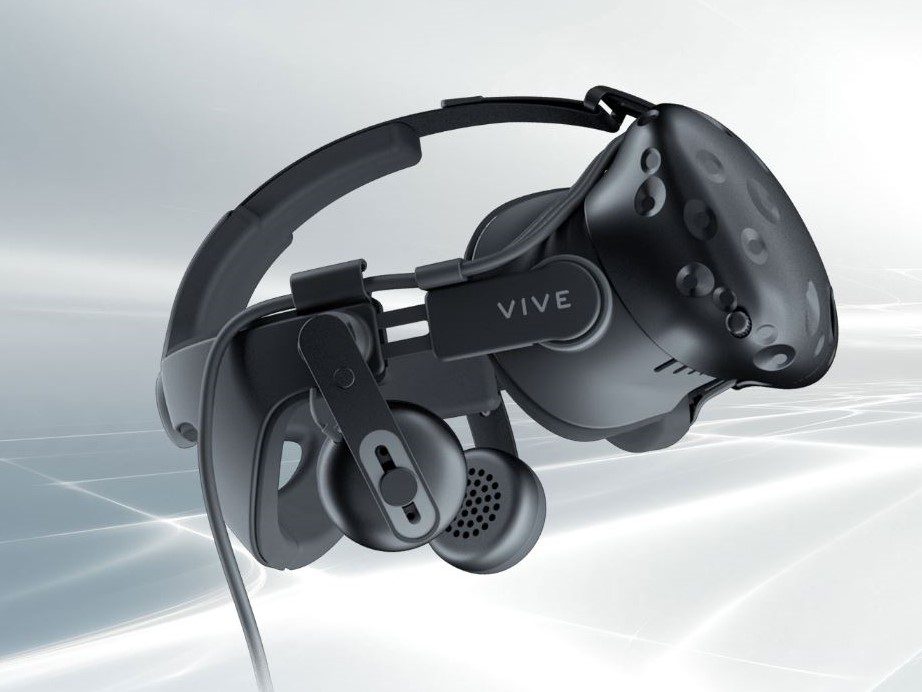The Vive virtual reality headset celebrated its one-year anniversary two months ago, but that doesn’t mean HTC will stop coming out with improvements. The Vive Deluxe Audio Strap is a replacement for the out-of-the-box headstrap that originally made up the back half of the headset. It is reported to fix a number of the Vive’s existing problems. First of all, the weightier audio strap balances the front-heavy weight of the Vive. Fit adjustment has become as easy as turning a dial, which means it’s that much easier to swap between friends. Finally, integrated on-ear adjustable headphones means you’re not going to get tangled in your headphones anymore.
The Vive Deluxe Audio Strap might be a boon for HTC developers in terms of creating experiences that focus on the immersive quality of sound and music. Especially for users who have gone without headphones in favor of playing sounds from television or computer speakers. In terms of fitness, a better way to hear audio can only help our VR workouts. And not only by allowing us to hear our workout music playlist better.

You’ve probably heard about how music makes a great exercise aid, but you might wonder where those assumptions came from. In truth, the interaction between music and physical exertion has been a subject of research for the last century. The findings show that music does indeed help you work out harder. In the early 1900s, American statistician Leonard Ayres found that cyclists pedaled faster when a live band was playing compared to those who cycled without external stimulation. One hundred years later, we have a website that can pair you with the ideal soundtrack depending on your mile time. But how exactly does music supplement our workout?
Running to the Beat
Music distracts people from the pain and fatigue of physical exertion, and one of the ways it does this is through its tempo. The tempo is the effective speed of a song and is usually measured in beats per minute (BPM). For example, Eminem’s ‘Till I Collapse,” a workout playlist favorite, has a BPM of 171. Research favors the songs with faster tempos. A 2012 survey with a sample of 184 undergraduate students found that hip hop, rock, pop, and country were the most popular types of workout music. When asked why they listened to their MP3 players at the gym, 22.4% of the students said it made them work out harder, 21.4% said it made exercise seem easier, and 20.2% said it make them work out longer.

From the data, it’s easy to assume that the faster the tempo, the better you are motivated. After all, the most popular genres from the survey tend to have greater BPMs. It turns out that it’s not so simple. It might be more accurate to say that you should choose music based on the level of effort you are aiming for. Your body will actually consume less oxygen when you are performing in time with the musical tempo as opposed to out of it. If you wanted to gamify your workout, you could progress to faster and faster songs. On the other side of the spectrum, once you reach a level of high-intensity performance, then it doesn’t matter how fast your song is. The physical strain is so great that your body has no choice but to concentrate on the exertion.
Motivated by Music
Thanks to the complicated computer that we call a brain and its fascinating ability to make associations, the whole context of a song also has an effect on its effectiveness as a distraction during our workouts. Think about a song that makes you happy. Does that song also remind you of a specific memory? Is it on the soundtrack of your favorite movie? Your individual perception of a song can literally inspire you to go the extra mile. Music’s power to elevate your mood by influencing your emotions is ideal when you’re gasping for breath on the treadmill.
By changing your perception of how much effort you’re putting out, you are able to work more. Dr. Costas Karageorghis, from London’s Brunel University School of Sport and Education, compared music to a drug. One that’s legal for athletes to use. He says that music “can reduce the perception of effort significantly and increase endurance by as much as 15 percent.” The effect is enough that USA Track & Field once tried to ban the usage of MP3 players at its official races reasoning that it gave athletes a competitive edge.
All Together Now
One of the main ways VR fitness distinguishes itself from traditional fitness is the social aspect. Due to the entry cost of VR hardware, it is not uncommon for a user to share their gear with friends. Taking turns with the headset is a past-time at this point. While running in marathons or workout out at the gym can be done in a group, exerting the effort will always be a solo venture. But is there a way to use music to make workouts a social activity? Cognitive scientist Tom Fritz might have found a way.
As part of a project that he refers to as Jymmin, gym equipment is used to produce electronic music. Fritz gathered non-athletes to work out on Jymmin machines in groups of three, and they effectively made their own workout music. The survey Fritz conducted found that the volunteers who made music together perceived less exertion than those who had a Jym session by themselves. The conclusion is notable because the volunteers had to be totally aware of their efforts to make music and not just noise. It goes against the distraction effect.
Jymmin is reminiscent of video games like Rock Band, which has players working together to recreate a song on their respective instruments. If the VR fitness games we have today are the one-player games of the past, then a theoretical game that includes everyone in the room means that VR will have graduated to LAN parties. It also comes with the added bonus of getting everyone in motion.
Setting the Stage with the Vive Deluxe Audio Strap
Like all forms of media, VR is a medium that is in a stage of constant improvement and innovation. With every change comes the possibility for new options and better ways to work out in VR. While integrated headphones are nothing new as far as headsets go, this release could pave the way for future VR fitness products that will do what the MP3 player did for running.
The Vive Deluxe Audio Strap was released June 6th, 2017, bearing a price tag of $99.99 USD and some reports indicate that they’re already sold out. We’ll keep watching HTC’s release schedule and let you know when more are available.












[…] Add-On and how Music Impacts Exercise – VR Fitness … – VR Fitness Insider (blog) More Information – Audio Factory demonstrates Google's VR spatial audio engine within Daydream – […]
[…] Add-On and how Music Impacts Exercise – VR Fitness … – VR Fitness Insider (blog) More Information – HTC finally starts selling Vive Deluxe Audio Strap, and it … – Digital […]